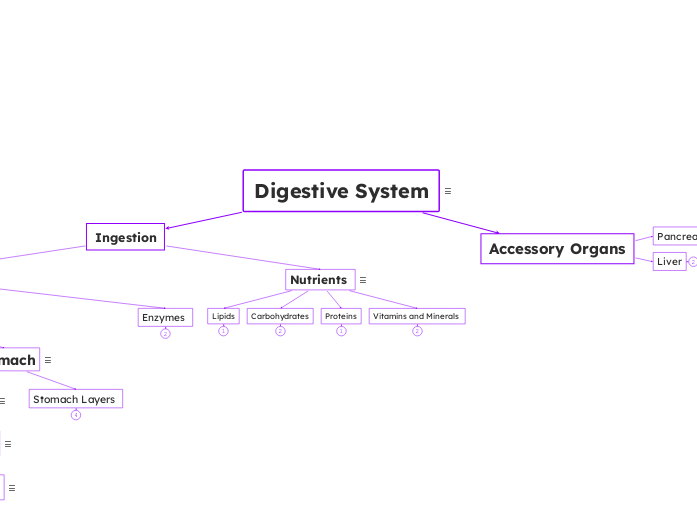af Miguel Clue 1 år siden
214
Digestive System

af Miguel Clue 1 år siden
214

Mere som dette
The Digestive System is responsible for the chemical and mechanical breakdown of all food that goes in and out of our body!
Subtopic
Nutrients are essential for an organism's survival, growth, and reproduction. an example of some nutrients are carbohydrates, lipids (fat), proteins, and vitamins + minerals!
Minerals are naturally occurring elements in the body that carry out metabolic chemical reactions and repair/build new tissues in our body. some of the minerals used to rebuild these tissues are calcium, sodium and iron.
Vitamins regulate the body's cell functions, growth, and development. Vitamins A, D, E, and K are known as fat solubles which means that they can be stored in the body's fat for use later, while Vitamins B and C are water soluble therefore they cannot be stored in the body's fat tissues and are excreted in the form of urine.
Proteins are one of the key building blocks of cells, they perform a multitude of tasks such as all metabolic activities
there are three main types of Carbohydrates, Monosaccharides, Disaccharides, Polysaccharides
Carbohydrates are made up of oxygen, hydrogen, and carbon. Carbohydrates are the body's main energy source during digestion, the sugars and starches are broken down into smaller sugars.
Lipids are fatty compounds that help our body to control what goes in and out of our cells, they also assist in storing energy, making hormones, and storing vitamins.
Ingestion begins in the mouth, where the food is broken down mechanically and chemically, our teeth are used to mechanically break down each food chunk into smaller pieces, making it easier for us to use our salivary glands and enzymes to break down this food!
These proteins also help us to digest our food, such as Amylase helps our body break down our food into tiny pieces that are swallowed
Enzymes are a group of proteins that help our body to speed up the chemical reactions that change our food into energy, also known as metabolism
The food stretches the wall of the Esophagus which initiates the smooth muscles to undergo rhythmic, wave-like contractions called peristalsis sphincter, which is a circular muscle, that contracts to close an opening in the body. The Esophagus is located at the center of our chest also known as the mediastinum.
Stomach
The Stomach is located in the upper left area of the abdomen below the liver, the function of the Stomach is to break down the food that we ingest using gastric acid which is built up with gastric lipase and pepsinogen. the food we eat that's in our Stomach activates nerves which increases muscular contraction which mixes food with gastric juices
Stomach Layers
The muscularis is the muscle layer of the stomach, its function is to contract to mix the food with the gastric acid to ultimately produce a semi-liquid known as Chyme which is used to pass digestive food into the small intestine
The Serosa is the outermost layer of the stomach, its function is to hold the stomach in place and secrete a liquid fluid which prevents movements between organs.
The submucosa is a bunch of connective tissues that contains a series of networks connecting nerves and blood vessels.
The mucosa is the innermost layer, it secretes gastric juice, it's main function is to facilitate movement inside the stomach and to create a barrier lining to protect the stomach from enzymes and acidic acids they also heal the stomach wall.
Small Intestine
The Small Intestine has three parts, the duodenum, jejunum, and ileum these parts function together to help further digest food coming from the stomach. the small intestine also absorbs nutrients (minerals, vitamins, proteins, etc.) Absorption in the small testing takes place using passive transport which is the movement of material across the cell membrane without using energy from the cell, this happens in the jejunum and small molecules like glucose and lipids.
Large Intestine
The large intestine is a long tube-like organ located in the lower abdominal cavity and it ends at the anus, its 3 primary functions are absorbing water and electrolytes, producing and absorbing vitamins, and forming and moving feces to the anus for elimination.
Anus
The Anus which is the end of our large intestine, is where all the food waste that has been mechanically processed and chemically digested goes to get defecated!
The Rectum
The Rectum is where all the food waste is stored and prepared to move to the anus for defecation!
Sphincters
The Sphincters also known as the gastroesophageal is located where the esophagus connects to the stomach, it's purpose is to prevent food and acid from moving up the esophagus, when this happens that is called an acid reflux or what many refer to as heartburn.
Metabolism is the process of taking food and turning it into energy! you may have heard people say they have a high or low metabolism. well if a person has a high metabolism that means they burn more calories and need more food to convert it into energy and if they have a low metabolism that means they burn fewer calories therefore they don't need more food to convert into energy
Catabolism
Catabolism is the process of metabolic reactions that break down larger molecules into smaller subunits
Anabolism
Anabolism is the process of building up metabolic reactions that use energy from the food we eat to produce larger molecules from smaller subunits